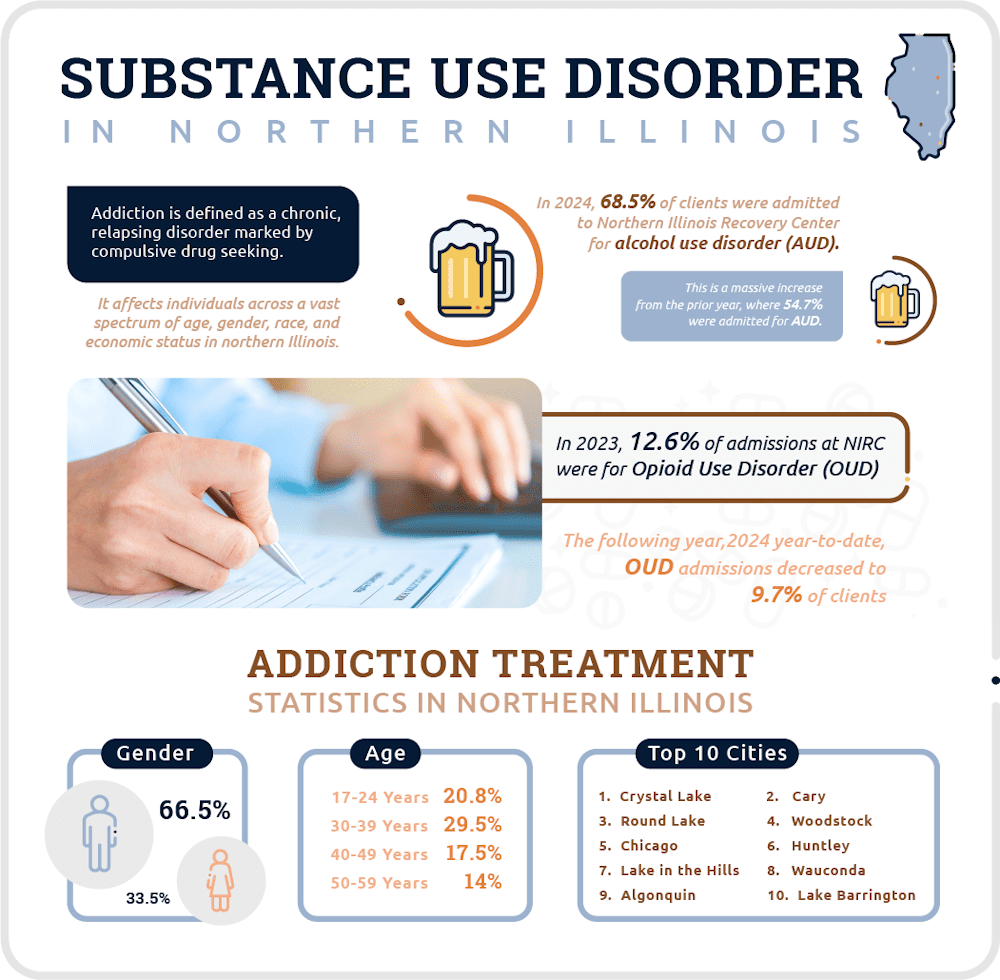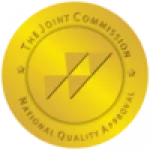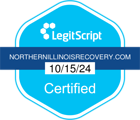Finding the most up-to-date information on substance use disorder and treatment in Illinois is a challenge. Many reliable sources, including opioid statistics and other key data from the Illinois Department of Public Health, are released with a significant time delay between data collection and publishing.
Using aggregated client data from Northern Illinois Recovery Center (NIRC), we’re taking a closer look at the current state of substance use and treatment in Northern Illinois—as well as how it’s changing over time.


Alcohol Rehab Statistics in Northern Illinois
This is a marked increase over the same time period in 2023, where AUD accounted for 54.7% of admissions.
The trend in admissions for AUD correlates with data from the Center for Disease Control (CDC) that shows an increase in deaths from ‘excessive alcohol use’ in the past two decades in the United States. In the same report, the CDC reported a 29.3% increase in deaths from excessive alcohol use between 2016 and 2021.
As a secondary diagnosis at NIRC, AUD was consistently less common, accounting for only 9% of secondary diagnoses in 2024 YTD and 7.7% of secondary diagnoses in H1 2023.
Opioid Rehab Statistics in Northern Illinois
In 2024 YTD, OUD as a primary diagnosis was found among 9.7% of clients: a decrease of more than three percentage points from the previous year.
This is in contrast to the trend in overdose deaths illustrated by the Illinois Department of Public Health (IDPH). According to the most recent data, the department reported an 8.2% increase in overdose deaths in the state of Illinois between 2021 and 2022, 83% of which involved opioids.
Data from the IDPH also shows that overdose deaths from heroin have been on a steady decline since 2013, while deaths from synthetic opioids have skyrocketed. This correlates with data from the CDC, which reported that synthetic opioids, including fentanyl, were involved in 70% of opioid overdose deaths in the US between 2018 and 2021.
OUD as a secondary diagnosis is statistically uncommon among clients at NIRC and was diagnosed in only 2.6% of clients in 2023.
Demographic Statistics for Alcohol & Drug Use Disorders in Northern Illinois

Addiction Treatment by Age Cohort
Those trends have shifted in 2024. The 40 to 49 and 30 to 39 year old age groups are tied this year, each accounting for 23.5% of clients. The 25 to 29 year old cohort has also seen a marked increase of more than one percentage point between 2023 and 2024.
Addiction Treatment by Gender Cohort
These statistics from Northern Illinois are consistent with wider research into addiction and gender differences. Men are more likely than women to develop a substance use order.
In 2023, 1% of clients were either transgender, unspecified, or preferred not to say.

Addiction Treatment by Geographic Cohort
- Crystal Lake, IL
- Cary, IL
- McHenry, IL
- Round Lake, IL
- Woodstock, IL
- Chicago, IL
- Lake In The Hills, IL
- Huntley, IL
- Wauconda, IL
- Algonquin, IL
In 2024, that list has changed. These are the 10 most common cities for NIRC clients this year:
- Crystal Lake, IL
- Cary, IL
- Round Lake, IL
- Woodstock, IL
- Chicago, IL
- Huntley, IL
- Lake In The Hills, IL
- Wauconda, IL
- Algonquin, IL
- Lake Barrington, IL
The cities that saw the greatest increase in clients were Round Lake, Woodstock, Chicago, Huntley, Algonquin, and Lake Barrington. The only city that saw a decrease was McHenry, while Lake In The Hills stayed consistent year-over-year.
About Northern Illinois Recovery Center
Disclaimers
This article is not intended for academic research or use. Statistics were generated using anonymous, aggregated client data collected by NIRC for the years 2023 and 2024 (to-date).




